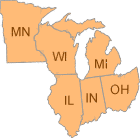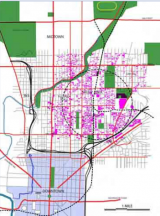Brownfields and Land Revitalization in Illinois, Indiana, Michigan, Minnesota, Ohio, and Wisconsin
The Land Revitalization Program in Region 5, which includes Illinois, Indiana, Michigan, Minnesota, Ohio, and Wisconsin, is focused on restoring land and other natural resources into sustainable community assets that maximize beneficial economic, ecological and social uses to ensure protection of human health and the environment.
- Land Revitalization Action Team
- Success Stories
Smart Growth Redevelopment District in Indianapolis, Indiana
The City of Indianapolis and local stakeholders delineated a ¾-mile Smart Growth Redevelopment District (SGRD), centered at East 22nd Street and the Monon Greenway Trail. The SGRD encompasses neighborhoods within Indianapolis that are challenged by crime, illegal dumping, a nearly 70 percent household poverty rate, abandoned houses and vacant lots, a concentration of brownfields with potential residential exposures to human health from soil and ground water contamination, and limited access to retail, jobs centers, transportation options, fresh food, and community services. See how the SGRD revitalization strategy is spurring investment and strengthening downtown Indianapolis.
Lick Run Watershed Strategic Integration Plan in Cincinnati, Ohio
EPA commissioned the Lick Run Watershed Strategic Integration Plan to outline coordinated actions, investments and decision-points that could be needed to implement a sustainable infrastructure program approach for combined sewer overflow control at the Metropolitan Sewer District of Greater Cincinnati (MSD). Sustainable infrastructure approaches to combined sewer overflow mitigation have been demonstrated to provide multiple social, environmental and economic benefits when coordinated with other revitalization efforts and investments. These benefits range from regulatory compliance and beautification to potential job training, land banking, and brownfields revitalization. Read more about the specific public investments, milestones and opportunities implementing a viable sustainable infrastructure.
Green Historic Preservation and Multi-Modal Station in Moline, Illinois
EPA Region 5 provided technical assistance to the City of Moline, Ill., and MetroLINK on a multi-modal transit station project that involves the rehabilitation and LEED certification of a historic building on a brownfield site. This site directly adjoins a large brownfields redevelopment project, the John Deere Commons, which helped to revitalize Moline's downtown. Eventual reuse of the site will spur additional reinvestment in surrounding properties, many of which are identified in the City's brownfield inventory. The station development will not only bring intercity rail service to the Quad Cities, it will also spark new redevelopment opportunities in the Moline downtown.
Business Plan for Brownfields and Urban Agribusiness in Toledo, Ohio
EPA worked with Lucas County Improvement Corporation, Toledo Community Development Corporation, University of Toledo, Center for Innovative Food Technology, The Collaborative, Toledo Grows, the city of Toledo, Ohio EPA and HUD to help Toledo CDC develop a business plan for a proposed urban farm on a property that has been vacant for over 15 years. The Fernwood Growing Center is on a 2-acre brownfield cleaned up with an EPA revolving loan grant from the city. It will provide fresh locally grown fruits and vegetables to the community, and encourage healthy diets and lifestyles by providing nutrition education and reconnecting people with locally grown foods. It will also help strengthen the local economy with jobs and job training.
- Highlights & Publications
- Targeted Brownfields Assessment (TBA)
Subtitle A of the Small Business Liability Relief and Brownfields Revitalization Act authorizes the United States Environmental Protection Agency (EPA) to establish a program to perform Targeted Brownfields Assessments (TBAs) such as Phase 1 and Phase 2 environmental assessments at properties within Region 5 at no cost to local governments, quasi-governmental agencies and tribes. Information gathered from a TBA gives local governments and Prospective Purchaser a better understanding of potential contamination issues at Brownfields sites in their communities.
EPA Region 5 has limited resources to help communities complete these TBAs.
This resource will be distributed on a first-come, first-served basis as funding allows and at sites selected in accordance with the criteria identified in the TBA fact sheet. (1)
EPA will select sites in accordance with the criteria outlined in the Targeted Brownfields Assessments Fact Sheet (PDF) (2 pp, 1.35 M, About PDF). In making final decisions on distribution of this resource to applicants, EPA may consider a balanced distribution among the Region 5 States and Tribes. EPA will review the request(s) and determine whether the property itself and the site assessment work are eligible; EPA will document that decision. Upon approval of TBA funding, EPA and/or the State can help refine community assessment needs, work expectations and timeliness.
* Complete and send the Sample Request Letter (DOC)(2 pp, 26 K)
* Complete and send the TBA Eligibility Questionnaire (DOC)(5 pp, 42 K)
* Complete, sign and send the TBA Access Consent Form
For further information regarding the EPA Region 5 TBA Program, please contact Brad Stimple at 440.250.1717 or by email at stimple.brad@epa.gov.
State Cleanup Programs within Region 5

State & Tribal Response Programs Agreements
Federally Recognized Tribes with 128(a) Brownfields Programs
- Fond Du Lac Band Lake Superior Chippewa, Minnesota
- Keweenaw Bay Indian Community, Michigan
- Lac Du Flambeau, Wisconson
- Leech Lake Band of Ojibwe, Minnesota
- Little River Band Ottawa, Michigan
- Little Travese Bay Bands of Odawa Indians, Michigan
- Lower Sioux Indian Community, Minnesota
- Menominee Indian Tribe of Wisconsin, Wisconson
- Mille Lacs Band of Ojibwe, Minnesota
- Nottawaseppi Huron Band Potawatomi, Michigan
- Oneida Nation Wisconsin, Wisconson
- Port Gamble S'Klallam Tribe, Wisconson
- Red Cliff Band of Lake Superior Chippewa, Wisconson
- Red Lake Band, Minnesota
- Saginaw Chippewa, Michigan


